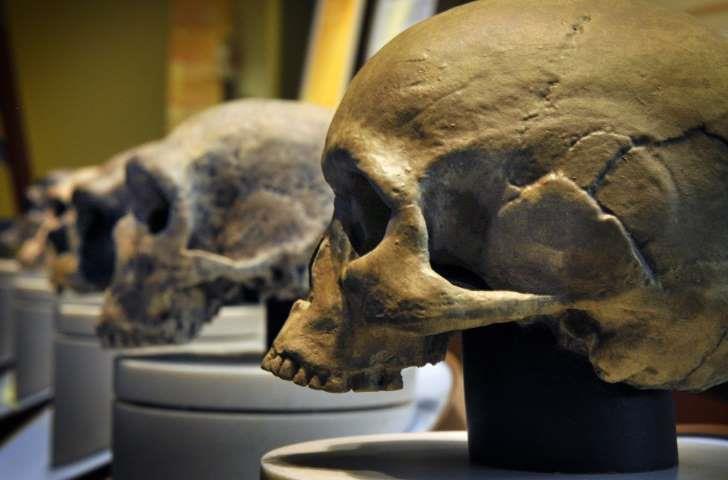




A Question OF Human Identity - Reference


Powered By Sispro1
Copyright All Rights Reserved by Nigel G Wilcox E-Mail: ngwilcox100@gmail.com
Complimentary Topics
Designed by Nigel G Wilcox
The Paragon Of Metal Detecting
& Archaeology
& Archaeology
Pages
Check out the Space Publication in the pseudo science section - Forbidden Archaeology - Introduction to The Denisovans
Scientists are still trying to piece together this evolutionary jigsaw puzzle based on a shifting cast of creatures that show up in the fossil record. To complicate things, most of the fossils found probably represent evolutionary side-branches rather than direct ancestors.
55m years ago - First primates evolve.
15m years ago - Hominidae (great apes) split off from the ancestors of the gibbon.
8m years ago - Chimp and human lineages diverge from that of gorillas.
4.4m years ago - Ardipithecus appears: an early "proto-human" with grasping feet.
4m years ago - Australopithecines appeared, with brains about the size of a chimpanzee’s.
2.3m years ago - Homo habilis first appeared in Africa.
1.85m years ago - First "modern" hand emerges.
1.6m years ago - Hand axes are a major technological innovation.
800,000 years ago - Evidence of use of fire and cooking.
700,000 years ago - Modern humans and Neanderthals split.
400,000 years ago - Neanderthals begin to spread across Europe and Asia.
300,000 years ago - Evidence of early Homo sapiens in Morocco.
200,000 years ago - Homo sapiens found in Israel.
60,000 years ago - Modern human migration from Africa that led to modern-day non-African populations.
What are some of the important fossils I should know about?
One of the earliest specimens that people believe lies on our lineage – or not far from it – is Sahelanthropus tchadensis, a six to seven-million-year-old fossil found in Chad. It has an ape-like sloping face, prominent brow and very small brain, but small human-like canine teeth. The spinal cord is positioned underneath the skull, rather than towards the back, which some say suggests the creature walked on two legs, but it’s hard to know for sure, since there’s just a skull and a few bones to go on.
Another fossil from around the same period found in Kenya, called Orrorin tugenensis (nicknamed Millennium Man), also features small teeth and a leg bone that indicates primitive bipedalism.
15m years ago - Hominidae (great apes) split off from the ancestors of the gibbon.
8m years ago - Chimp and human lineages diverge from that of gorillas.
4.4m years ago - Ardipithecus appears: an early "proto-human" with grasping feet.
4m years ago - Australopithecines appeared, with brains about the size of a chimpanzee’s.
2.3m years ago - Homo habilis first appeared in Africa.
1.85m years ago - First "modern" hand emerges.
1.6m years ago - Hand axes are a major technological innovation.
800,000 years ago - Evidence of use of fire and cooking.
700,000 years ago - Modern humans and Neanderthals split.
400,000 years ago - Neanderthals begin to spread across Europe and Asia.
300,000 years ago - Evidence of early Homo sapiens in Morocco.
200,000 years ago - Homo sapiens found in Israel.
60,000 years ago - Modern human migration from Africa that led to modern-day non-African populations.
What are some of the important fossils I should know about?
One of the earliest specimens that people believe lies on our lineage – or not far from it – is Sahelanthropus tchadensis, a six to seven-million-year-old fossil found in Chad. It has an ape-like sloping face, prominent brow and very small brain, but small human-like canine teeth. The spinal cord is positioned underneath the skull, rather than towards the back, which some say suggests the creature walked on two legs, but it’s hard to know for sure, since there’s just a skull and a few bones to go on.
Another fossil from around the same period found in Kenya, called Orrorin tugenensis (nicknamed Millennium Man), also features small teeth and a leg bone that indicates primitive bipedalism.

© getty The Smithsonian Museum of Natural History in Washington displays a row of skulls of homo sapiens
Slightly later, at 4.4m years, there is Ardipithecus ramidus (Ardi), a stunningly complete female skeleton found in Ethiopia. Ardi, who had a stocky frame and stood almost four feet (one metre) tall, had gangly ape-like arms and grasping big toe, suggesting she would have been an agile climber. Scientists are divided on the extent to which Ardi walked upright – some say she would have walked on two legs routinely, others think she would have just about managed it if she needed to use her arms to carry something. The pelvis bones are crushed and the skeleton does not include a knee, which could have helped resolve the question more definitively.
The strongest evidence for Ardi being a direct ancestor, or very close to our lineage, comes from her teeth, which were small and stubby – more like modern human teeth – and lacked the large fang-like canines of chimpanzees, gorillas and earlier extinct apes.
Then comes Lucy , a 3.18m-year-old skeleton, named after the Beatles song Lucy in the Sky with Diamonds, the soundtrack to the 1974 excavation. Lucy is viewed as one of the most important discoveries in palaeontology as she is a unique amalgam of primitive features a chimpanzee-sized brain, a powerful jaw and long, dangling arms and incredibly human ones. In particular, her legs, knee and pelvis are strikingly similar to our own anatomy, suggesting that by this point our ancestors had gained the distinctive human abilities of being able to walk and run.
Lucy also helped cement a growing acceptance of Africa as the cradle of humanity, reflected in her species scientific name: Australopithecus afarensis. Scientists now think that the australopithecine genus (in the taxonomical hierarchy, genus is one up from species) gradually evolved and spread across southern and eastern Africa and that one of these species seeded the next phase of our evolution.
Why did our ancestors start walking upright?
The traditional savannah theory held that shifts in the climate led to dense forests being replaced by sweeping grasslands, creating a new incentive for being able to travel long distances by foot. Yet the transition towards bipedalism appears to have started at least six million years ago long before the African climate dried out enough to create savannahs. To complicate matters further, a recent analysis of the Lucy fossil suggests that multiple fractures had been sustained shortly before her death, leading some to speculate that she may have died falling out of a tree.
Then comes Lucy , a 3.18m-year-old skeleton, named after the Beatles song Lucy in the Sky with Diamonds, the soundtrack to the 1974 excavation. Lucy is viewed as one of the most important discoveries in palaeontology as she is a unique amalgam of primitive features a chimpanzee-sized brain, a powerful jaw and long, dangling arms and incredibly human ones. In particular, her legs, knee and pelvis are strikingly similar to our own anatomy, suggesting that by this point our ancestors had gained the distinctive human abilities of being able to walk and run.
Lucy also helped cement a growing acceptance of Africa as the cradle of humanity, reflected in her species scientific name: Australopithecus afarensis. Scientists now think that the australopithecine genus (in the taxonomical hierarchy, genus is one up from species) gradually evolved and spread across southern and eastern Africa and that one of these species seeded the next phase of our evolution.
Why did our ancestors start walking upright?
The traditional savannah theory held that shifts in the climate led to dense forests being replaced by sweeping grasslands, creating a new incentive for being able to travel long distances by foot. Yet the transition towards bipedalism appears to have started at least six million years ago long before the African climate dried out enough to create savannahs. To complicate matters further, a recent analysis of the Lucy fossil suggests that multiple fractures had been sustained shortly before her death, leading some to speculate that she may have died falling out of a tree.
(Early Humans pgs-5-8)
Member NCMD
Reference Menu




















